Spiders with Striped Legs (with Pictures) – Identification Guide
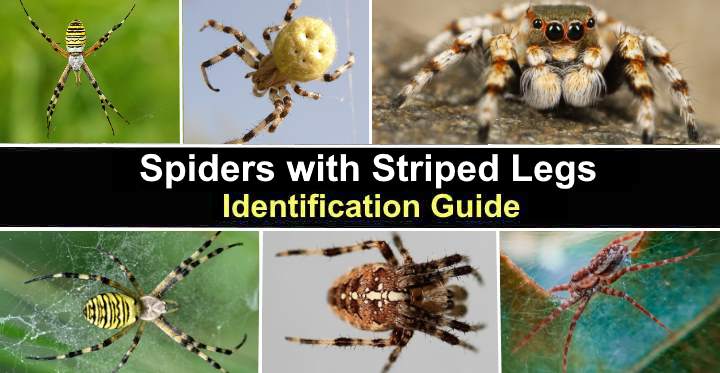
Spiders with striped legs are common in the arachnoid kingdom. Many common brown spiders have striped legs, for example, the brown widow, common house spider, and the barn funnel weaver. Also, several species of orange, black, and red spiders have colored bands on their eight legs. Spiders with stripy legs can be small, like the American house spider, or large brown spiders, like the dark fishing spider. These unique spider leg markings help identify the spider species.
Spiders are known for their scurrying movements, fascinating webs, and, sometimes, frightening appearance. Stripes on spider legs help them blend in with their surroundings. Very often, the color of striped legs matches the spider’s body coloration. For example, the black and yellow garden spider has black and yellow striped legs.
Accurate spider identification is crucial to tell dangerous, venomous spiders with striped legs apart from harmless spiders. Examining unique markings on spider legs can help identify the species.
This article is an identification guide to spiders with striped legs. Descriptions and pictures of various spider species with distinct leg patterns will help you recognize and learn about these fascinating arachnids.
How to Identify Spiders with Striped Legs
To identify a spider species with striped legs, look at its body shape, distinct coloration or pattern, body size, and leg size. Some striped-legged spiders have fuzzy or hairy bodies, whereas others have smooth bodies. You may notice distinctive patterns as well as stripes on the legs.
Spiders are a group of easily recognizable arthropods in the order Araneae. Unlike insects, spiders have eight legs and two body parts—a cephalothorax and abdomen. With all spiders, the four pairs of legs are attached to the cephalothorax, which is the fused head and thorax.
Pictures of spiders can help with identification. It’s also good to note that the size of spiders generally refers to their body size, excluding their legs. Therefore, a spider with long striped legs could appear much larger than its body size. For example, the cellar spider only measures 0.31” (8 mm), but its stripy legs can grow to 2” (50 mm).
Types of Spiders with Striped (with Pictures) – Identification Guide
Brown Spiders with Striped Legs
Many types of brown spiders have striped legs. Let’s look in detail at the most common species of brown spiders you are likely to find in your home or garden.
American House Spider (Parasteatoda tepidariorum)
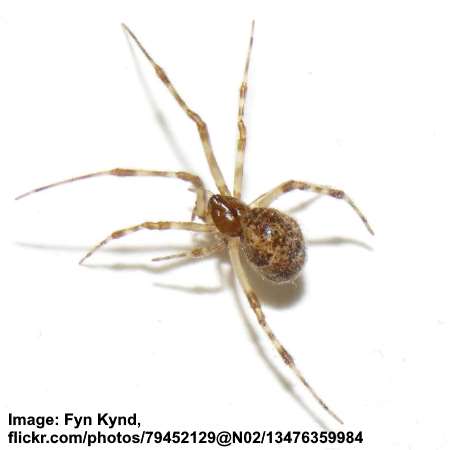
The American house spider is a common tan-colored spider with pale brown legs and dark brown stripes. It’s easy to identify by its bulbous abdomen with brown or gray coloration and mottled patterns. This small spider measures 0.2” to 0.24” (5 – 6 mm). The males are slightly smaller than female spiders – a common feature of spiders.
Signs you may have an American house spider are its messy, irregular webs in corners, crevices, and other undisturbed areas of homes and buildings. Common house spiders are not aggressive and are generally harmless to humans. The brown spiders can be beneficial in the home because their diet consists of small flies, mosquitoes, and ants.
Pantropical Huntsman Spider (Heteropoda venatoria)
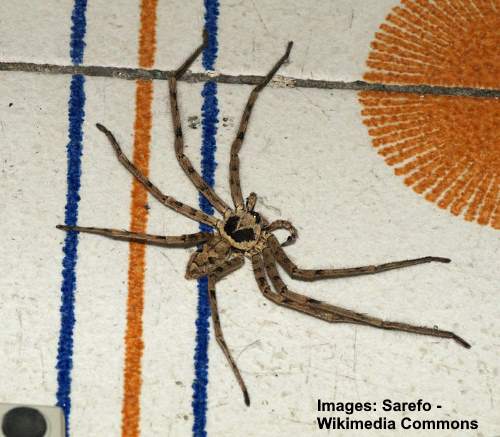
The pantropical huntsman spider is a large brown spider with dark brown stripes on its long, slender legs. Identifying features of the spider are its flattened, oval abdomen, creamy-yellow patch on its face, and thin, hairy legs. It doesn’t spin webs.
The brown spider measures 0.8” to 1” (20 – 25 mm) and has a leg span of up to 5” (120 mm). This brown spider with striped legs is common in Texas and Florida. Despite its intimidating appearance, speed, and agility, it’s not considered dangerous to humans. It is generally non-aggressive and will only bite if threatened or provoked.
Cellar Spider (Pholcus phalangioides)
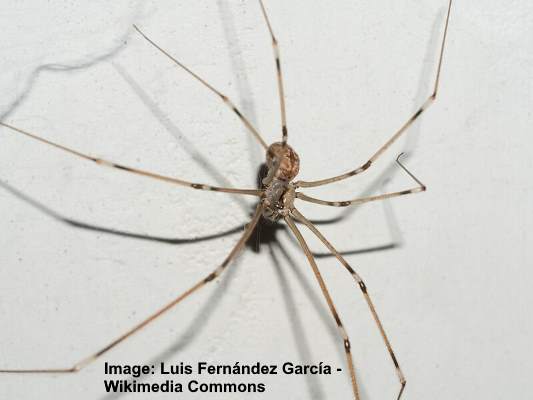
The cellar spider is a small, brown spider with exceedingly long, thin legs with dark-colored stripes. The long-bodied cellar spider is identified by its tear-shaped gray-pale brown color, peanut-shaped cephalothorax, and spindly legs. This common brown house spider measures 0.23” to 0.39” (6 – 10 mm) in body length, with a leg span of up to 2” (50 mm).
The harmless cellar spider is commonly found in dark, damp areas such as basements, crawl spaces, and cellars, hence its name. Also known as the daddy longlegs spider, the long-bodied cellar spider has eight eyes, unlike other spiders in the family Pholcidae, which have six eyes.
Brown Widow Spider (Latrodectus geometricus)
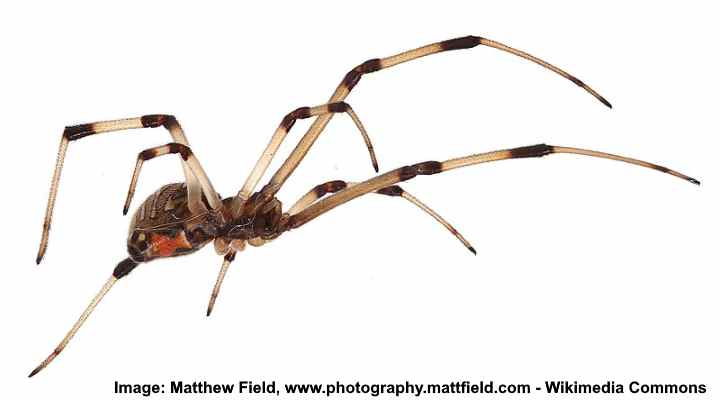
The brown widow spider is a venomous dark brown spider with dark brown stripes on pale tan-colored legs. The identifying feature of the spider is its characteristic orange or yellow hourglass marking on its abdomen. The female brown widow spider measures 0.3” to 0.5” (8 – 12 mm) long.
The brown widow spider is found in warm climates like Florida, Texas, and Arizona. Like all widow spiders, this dark brown spider delivers a painful bite. However, its venom is less toxic than its black and red counterpart—the black widow. It usually lurks in dark, undisturbed places like under eaves, in garages, and outdoor furniture.
Spotted Orb-weaver (Neoscona crucifera)
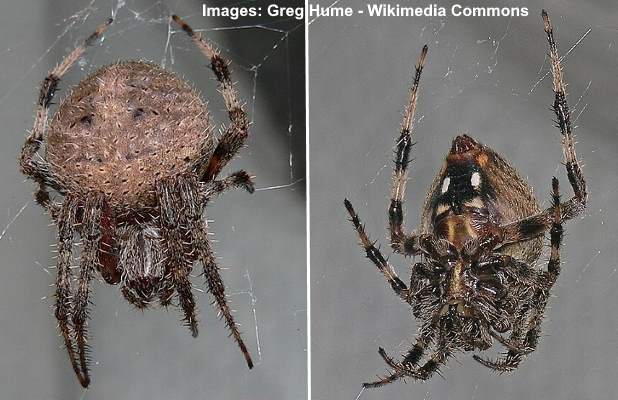
The spotted orb-weaver spider is a brown spider with light and dark brown stripes on its legs. The medium-sized spider is identified by its hairy abdomen with a black underside and two distinct white spots. Adult female spotted orb weavers measure 0.37” to 0.75” (9.5 – 19 mm) long.
Also called barn weavers, spotted orb-weavers are known for their elaborately orb-shaped webs. These large, round, sticky webs can be seen in gardens, fields, wooded areas, and buildings. The brown spider is not considered dangerous and only bites when threatened. Other colorations of the spider include rusty red or golden orange. However, the spiders always have striped legs.
Dark Fishing Spider (Dolomedes tenebrosus)
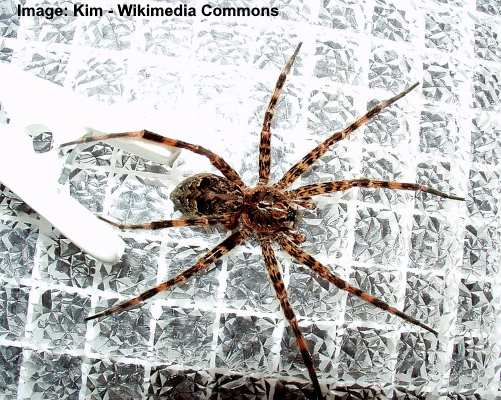
The dark fishing spider is a large dark brown spider known for its huge brown legs with orange-brown stripes. This fishing spider species is also identified by chevron markings on its abdomen contrasting with pale brown patterns. The females measure 0.59” to 1.02” (15 – 26 mm), twice the size of the males.
As its name suggests, the dark fishing spider hunts for its prey near water. Its stout body and long legs allow it to move quickly and efficiently. You often find the dark-colored spider in wooded areas on trees.
Barn Funnel Weaver (Tegenaria domestica)
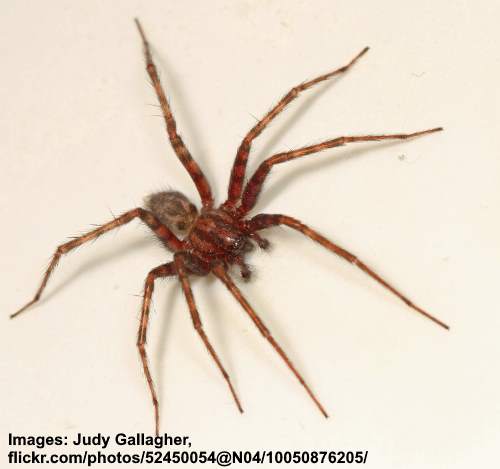
The barn funnel weaver is a type of brown domestic house spider identified by its striped legs and abdomen. The brown spider has a large, elongated oval abdomen and a small head. It is typically dark brown, orange, beige, or grayish with mottled patterns and chevrons running from top to tail.
The barn funnel weaver typically reaches a size of 0.30” to 0.45” (7.5 – 11.5 mm). It’s an agile hunting spider that catches prey with quick movements and speed. Signs of funnel weaver spiders are the distinct funnel-shaped webs they use to catch prey. The spider hides in the funnel’s narrow end, waiting for insects to become trapped in its web.
American Grass Spider (Agelenopsis)
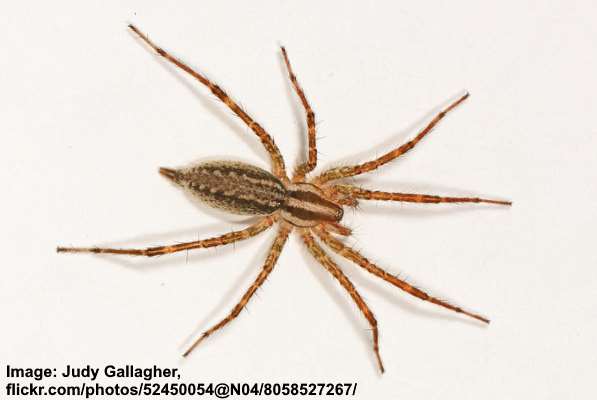
The American grass spider is a common tan-colored garden spider with banded brown and orange legs. This harmless native spider has a distinctive elongated tan body with dark brown stripes on the cephalothorax and zig-zag patterns on its abdomen. It grows to a size of 0.74” (19 mm) and has two rows of four eyes.
The American grass spider has a distinctive appearance due to its long front orange legs with faint yellowish and brown stripes. Despite its large size, the spider doesn’t bite humans and isn’t aggressive. It typically scurries away if it senses danger.
Other Types of Spiders with Striped Legs
It’s not just brown spiders that have striped legs. Other types of red, yellow, orange, and black spiders have distinctive bands on their legs.
Yellow Garden Spider (Argiope aurantia)
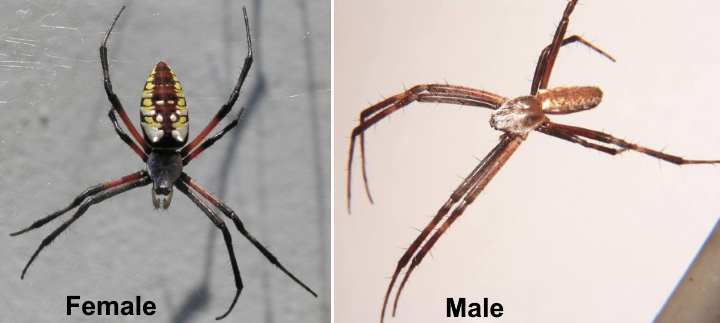
The yellow garden spider is a large spider with distinctive orange and black striped legs and yellow and black coloration on its abdomen. Other identifying features of the large, colorful spider are its yellow spots and stripes on its black abdomen, small cephalothorax covered in fine whitish hairs, and long legs.
The black and yellow spider measures 1” (25 mm) long and has a leg span of up to 3” (70 mm). Distinctive features of this spider are the way it rests in an ‘X’ shape and white zig-zag patterns in the web’s center.
Also called the golden garden spider, zipper spider, zig-zag spider, or corn spider, the spider can bite. But its bite is no worse than a bee’s sting.
Banded Garden Spider (Argiope trifasciata)

The banded garden spider is a colorful spider with four pairs of striped legs. The large spider is identified by its yellow, white, and black bands on its abdomen. The female’s ventral side has a yellowish ‘V’-shaped marking and orange coloration. The large garden spiders grow up to 1” (25 mm) long.
Like all spiders in the genus Argiope, the banded spider creates huge circular webs in gardens with a distinct zig-zag marking in the center. Some of the webs can be 2 ft. (0.6 m) wide. Although the spiders look large and menacing, they are harmless and only bite when threatened.
Wasp Spider (Argiope bruennichi)
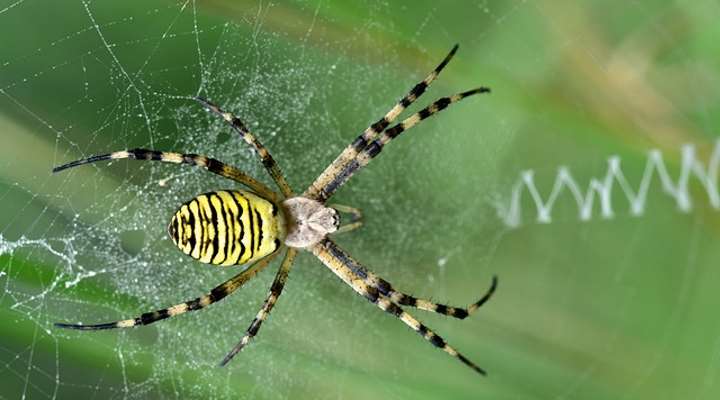
The wasp spider is a striking black and yellow spider with colorful striped legs. Its legs have a wide yellow or orange band near the body and black and yellow stripes along their length. The orb-spinning garden spider measures 0.60” (15 mm) long. Its egg-shaped abdomen has white, yellow, and black stripes.
Like all Argiope spiders, the wasp spider is known for its intricate and symmetrical orb-shaped web with zig-zag patterns and resting in an ‘X’ position. The striking garden spider is active for a few weeks in summer.
Bold Jumping Spider (Phidippus audax)
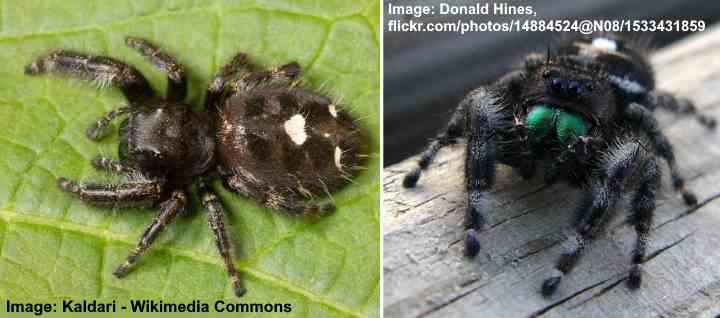
The bold jumping spider is a small, furry black spider with black and white striped legs. This black spider is easily identifiable by its black body with three reddish-orange or white heart-shaped spots. The hairy black spider has a compact and robust build and measures 0.15” to 0.7” (4 – 18 mm).
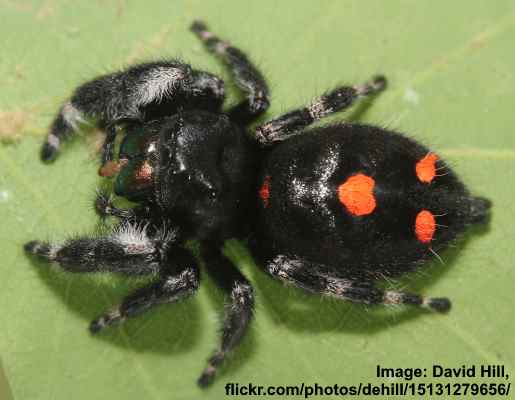
Bold jumping spiders are known for their agility and jumping ability, which they use to catch live prey. These black spiders with striped legs are harmless and only bite if mishandled.
Zebra Jumping Spider (Salticus scenicus)
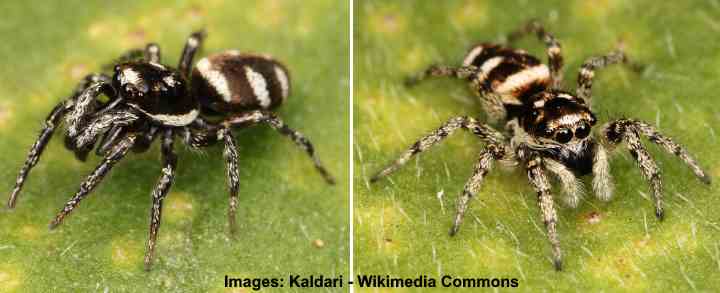
Zebra Jumping Spider (Salticus scenicus): male (left) and female (right)
The zebra jumping spider is a small black-and-white striped spider with black stripes around its grayish-white legs. The small spiders measure 0.19” to 0.35” (5 – 9 mm) long. As their name suggests, the spider’s identifying feature is white zebra-like stripes across its black abdomen.
The garden spider is common in yards during the summer. You will often find the black and white spider on fence posts, tree trunks, and walls of buildings. They use their excellent vision for hunting and spinning silk thread when jumping.
Marbled Orb-Weaver (Araneus marmoreus)
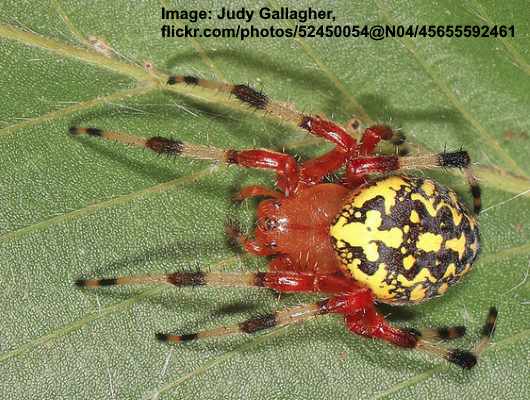
The marbled orb-weaver spider is an unusual orange spider with black and beige striped legs. It’s an easily identifiable spider due to its bulbous orange abdomen with grayish marbling patterns. However, there is variation in the species, with some species having a yellow rounded abdomen. In contrast, others have a white abdomen with zig-zag patterns.
With its banded legs, the colorful marbled orb-weaver spider grows 0.4” to 0.78” (10 – 20 mm) long. You can find the orange spider in shrubs, trees, tall weeds, and sometimes along the banks of streams.
Golden Silk Orb-Weaver (Trichonephila clavipes)
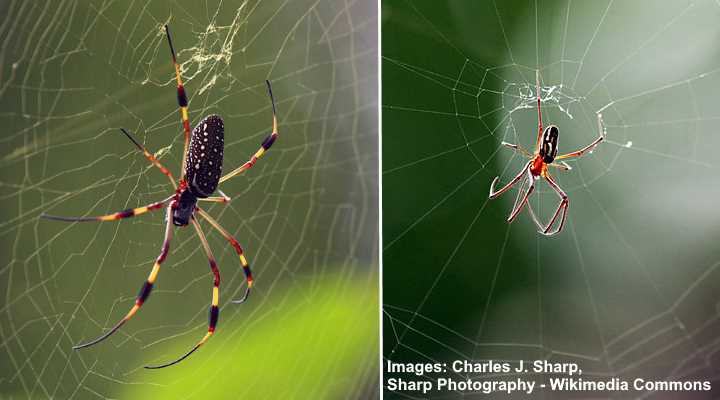
Golden silk orb-weaver spiders: female (left) and male (right)
The golden silk orb-weaver is one of the largest orb-weaver spiders with striped legs. The garden spiders are identified by their orange-brown abdomen, elongated black body with white spots, and dark yellow and brown banding on their legs. The colorful stripy-legged spiders measure 0.94” to 1.57” (24 – 40 mm) long.
The vibrantly colored spiders are common throughout the year in the southern states of the US. The golden silk orb-weaver is not considered dangerous to humans, although its bite can cause mild irritation and swelling. They primarily feed on small flying insects, such as moths and flies, that become trapped in their webs.
Joro Spider (Trichonephila clavata)
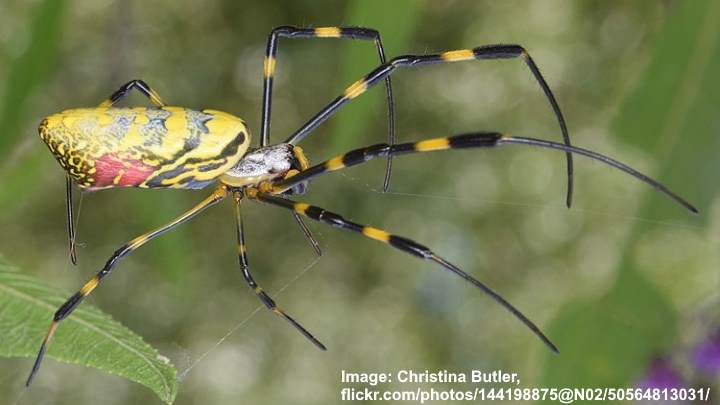
The striking Joro spider has yellow and dark blue abdominal patterns and long black legs with yellow bands. The spider’s identifying features are its golden-yellow oval abdomen, bluish stripes, and reddish patterns on its sides. It also has a white patch on its small head.
The adult spider grows 0.67” to 1” (17 – 25 mm) long, but its huge 4” (100 mm) leg span makes them appear enormous. Despite their intimidating appearance, Joro spiders are not dangerous or aggressive to humans. But, like most spiders, they bite when threatened.
Red-Femured Spotted Orb-weaver (Neoscona domiciliorum)
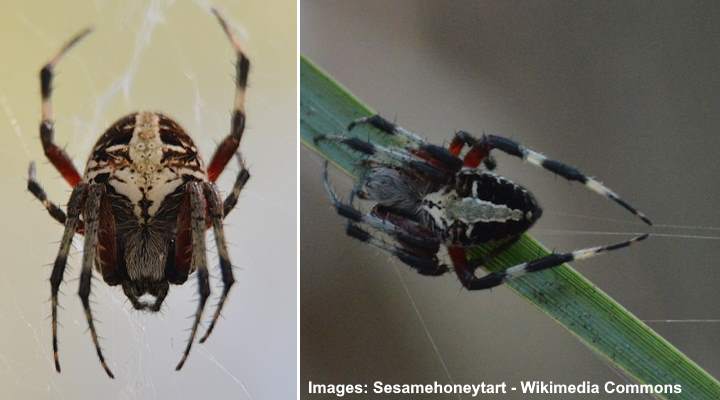
The red-femured spotted orb-weaver is identified by its black, red, and whitish-gray banded legs and creamy-white stripe on its abdomen. Characteristics of the spider are its black stripes on either side of a cross-shaped mark on its back, and striped, spiny legs. The adult female spiders grow 0.28” to 0.63” (7 – 16 mm) long.
This spider is native to Texas and is found in woodland habitats and gardens. In Florida, the spider is common in moist woodlands in the fall. However, their nocturnal habits make them difficult to spot in the daytime.
Gray Cross Spider (Larinioides sclopetarius)
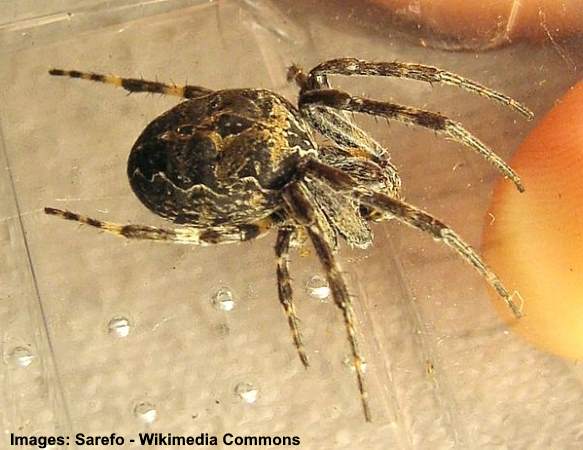
The gray cross spider is a common brown spider with mottled patterns and brown and yellow striped legs. The small brown spider grows 0.18” to 0.27” (4.5 – 7 mm). An identifying feature of this small spider is its grey to light brown abdomen with a prominent cross-like pattern.
The gray cross spider spins intricate orb-shaped webs between plants, trees, or other structures. The small brown spider with striped legs is common in North America and usually lives near water. The orb-weaving spiders hunt at night and are attracted to light.
Dimorphic Jumping Spider (Maevia inclemens)
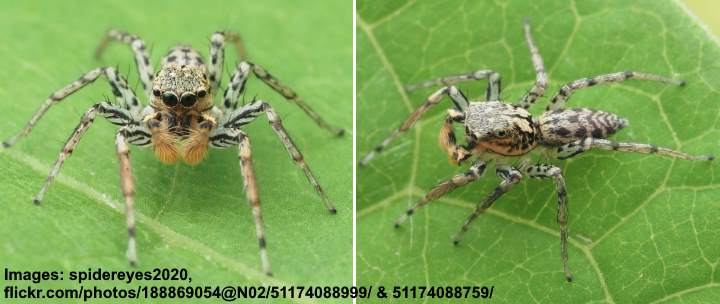
The dimorphic jumping spider is a small spider with spiny, striped legs. The spider can vary in coloration but typically has black and gray stripes all over its body and legs, as well as orange pedipalp. Adult female dimorphic spiders grow 0.26” to 0.31” (6.5 – 8 mm), and the males are slightly smaller.
As their name suggests, these spiders have an impressive jumping ability. They are common in yards through the mid-western US and can be found as far south as Texas, Louisiana, and Florida.
Spitting Spider (Scytodes thoracica)
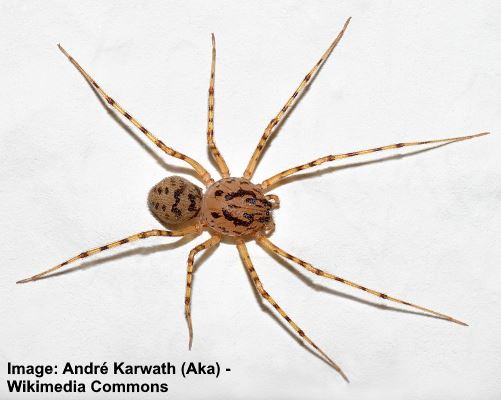
The spitting spider is a small tan-colored spider with a large oval cephalothorax, a smaller abdomen, and long yellow and black striped legs. Identifying features of this spitting spider are its yellow or pale brown color, black dots and markings on its body, and large mandibles. The small spider measures 0.12” to 0.24” (3 – 6 mm).
A characteristic of the spider is how it spits silky venom in a zig-zag pattern to cover its prey. Additionally, the spider has six eyes—not the typical eight that most spiders have. It’s good to note that the venom is not harmful to humans but can cause irritation if it comes into contact with the skin or eyes.
Spitting spiders are commonly found in gardens and forests in the southern states. However, it’s only found in houses in northern states because it likes warm environments.
Beach Wolf Spider (Arctosa littoralis)

The beach wolf spider is a sandy brown medium-sized spider with robust, spiny, striped legs. The cephalothorax and abdomen are brown with darker ring-like markings. It has stripy legs that are tan and dark brown bands. It uses its strong legs to bury in the sand to catch small insects.
The beach wolf spider grows 0.43” to 0.59” (11 – 15 mm) and is commonly found on sandy beaches and dunes when it is active from February to November. The sandy-brown spider is known for its speed and agility, which it uses to hunt insects and other small prey. Despite its name, the beach wolf spider is not aggressive towards humans and is not considered dangerous.
Related articles:
